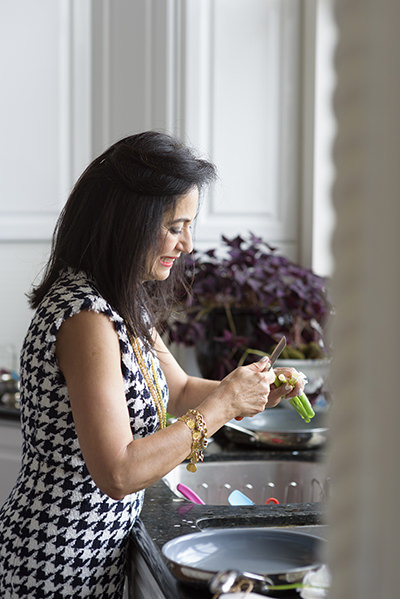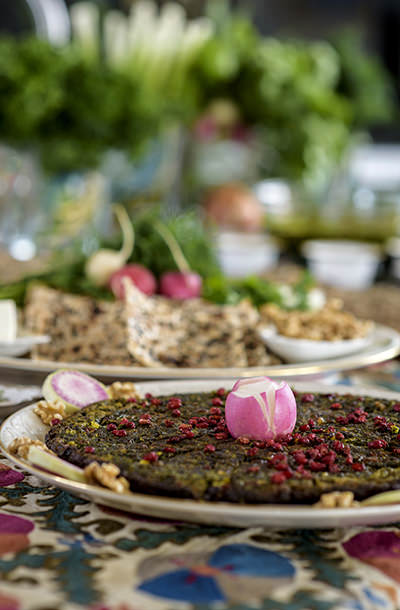Singer, pianist, artist, philanthropist Catherine Farahi cooks from memories of her home country.
While growing up in Tehran, Iran, Catherine Banayan Farahi was exposed to a mix of Persian, French, and Jewish cultures, foods, languages, and traditions.
“I was raised bilingual, speaking Farsi and French, since my father spent his adolescence in Paris,” Farahi says.
While her mother primarily cooked traditional Persian cuisine — many rice-based dishes, stews, and kebabs — her father brought French techniques into the kitchen.
“Back before there was ready-made mayonnaise, I remember my dad making homemade mayonnaise and beating it with a fork,” she says. “That was one of the many things that he brought with him back to Iran.”

Farahi stirs eggs into the vegetarian dish kuku sabzi, which is largely comprised of fresh herbs
A new adventure
In elementary school, Farahi learned English, and upon graduating high school in Iran, she moved to Pennsylvania to attend the University of Pittsburgh. She soon was accepted into the School of the Art Institute of Chicago. But then she met and, after a few months of long-distance dating, married her husband, John Farahi, now chief executive officer of Monarch Casino & Resort Inc., the parent company of Reno’s Atlantis Casino Resort Spa.
She moved to Reno, where Farahi finished her degrees — in visual arts and music — and began to sing with the Nevada Opera. She remains an artist at heart — being a calligrapher, sculptor, and painter (in acrylic, oil, pencil, and silk art).
One of Farahi’s favorite Persian meals to make when she moved to America was a frittata-like dish called kuku sabzi.
“It’s made with a lot of fresh herbs, sautéed onions, and eggs,” Farahi says. “I experimented with making it with other vegetables like broccoli, mushrooms, eggplant, and potatoes.”
But when Farahi arrived in Reno 40 years ago, finding some of the ingredients to make Persian dishes was difficult.
Persian cuisine involves many stews made from meats, nuts, vegetables, and herbs served alongside rice — sometimes with a pan-fried layer of crust at the bottom called tahdig. Common seasonings include saffron, cinnamon, and turmeric, and rice dishes may include herbs, raisins, beans, carrots, pomegranates, prunes, apricots, and more.
“There were many things I had to bring in from Los Angeles or San Francisco. We couldn’t find a lot of the herbs here,” says Farahi, pointing to dried key lime and the sweet and nutty seasoning fenugreek as examples.
“There’s a Middle Eastern market in Reno called Aladdin’s that carries the spices,” she says. “This market also brings in some Persian bread (sangak), which is absolutely out of this world.”
Once settled in Reno, Farahi also began to cultivate jasmine, using clippings from her sister’s plants and techniques learned from her father. She dries out the white flowers from her 20 large plants to season rice.
“They thrive in the beautiful sun of Reno, but they cannot survive the winters, so I bring them in,” she says. “I love to share clippings with friends and family.”
Taste of home

Catherine Farahi prepares kuku sabzi, a traditional Persian New Year’s dish served at the start of spring, in her Reno home
While raising their four now-grown children in Reno, Farahi cooked a mix of all different cuisines, but her Persian meals always were the most requested.
“The kids know all the Persian dishes, and they have their favorites,” Farahi says. “When they come home to visit, it’s what I make for them. They like Mom’s Persian home cooking.”
Though Farahi mostly cooks from memory and taste, when she’s hosting a dinner party or wants to make a special meal, she turns to Roza Montazemi’s Honar-e Ashpazi (Art of Cooking). Now in its 41st edition, the cookbook contains more than 1,700 Persian recipes and was hugely influential in Iran.
“With Persian dinner parties, you don’t just make one dish. You make several dishes,” Farahi explains.
Using another of her well-worn cookbooks by Najmieh Batmanglij, an Iranian-American cookbook author, Farahi and the staff at the Atlantis bring a taste of Iran to Reno through a multicourse Persian wine dinner. This past year, the menu featured dishes such as decadent pistachio soup, saffron Cornish hen kebabs, and fessenjan, a Persian pomegranate and walnut stew — in this case made with duck. All courses were paired with wines by Darioush, a Napa winery with Iranian roots.
Together, John and Catherine have made philanthropy a priority to help bring the arts to the Reno-Tahoe community. Though their influence can be found through such events as these as well as Catherine’s work on boards ranging from the Nevada Museum of Art; the University of Nevada, Reno Foundation; the Reno Chamber Orchestra; and the Reno Philharmonic to the United Jewish Communities, Temple Emanu-El of Reno, and Hillel of Northern Nevada, their most treasured achievement remains their family.
“My greatest accomplishment is having raised four kind and high-achieving individuals who are committed to doing good for the world,” she says.
Freelance writer Claire McArthur was fascinated by Farahi’s life story and would love to hear her sing just as much as she’d like to dive into one of her Persian feasts. You can reach her at Clairecudahy@gmail.com.
Mark Your Calendar
To enjoy a delicious taste of Jewish cuisine and culture, reserve space for a Shabbat dinner and a movie (The Last Resort, sponsored by John and Catherine Farahi) taking place at 5:30 p.m. Friday, June 28 at the Nevada Museum of Art in Reno. The event is coordinated by the museum team, including Mark Estee, who will be joined by Josh and Whitney Deri of Blend Catering. For details, visit the events section on Nevadaart.org.
Kuku Sabzi
(courtesy of Catherine Farahi, singer/pianist/ philanthropist in Reno. Serves 4)

1 cup fresh spinach, finely chopped
1 cup fresh dill, finely chopped
1 cup fresh parsley, finely chopped
⅓ cup fresh mint, finely chopped
¼ cup fresh tarragon, finely chopped
1 cup green onions or chives, finely chopped
1 cup cilantro, finely chopped
1 teaspoon dried fenugreek leaves (optional)
3 medium yellow onions, finely chopped
1⅓ cups walnuts, 1 cup halved to be served with the final dish, plus ⅓ cup chopped to be added to mix before cooking (optional)
6 large eggs
½ cup oil
½ teaspoon salt
1 teaspoon freshly ground pepper
½ teaspoon turmeric
⅓ cup barberries, washed and dried with 1 tablespoon saved for garnish (optional)
To start, wash and dry all herbs before finely chopping by hand or in a food processor. Next, sauté the chopped onions with 2 tablespoons of oil in skillet over medium heat until golden. Remove and let cool. In large mixing bowl, add all chopped herbs, onions, salt, pepper, turmeric, chopped walnuts, and barberries. Crack eggs over mixture and gently beat them into ingredients until evenly spread.
Add 3 tablespoons oil to a frying pan and bring to medium heat. Once heated, pour egg mixture in and rotate pan to spread mixture evenly. Cover with lid and cook 12 to 15 minutes while periodically drying inside of lid to remove condensation. Once egg has set, remove pan from stovetop, and, using oven mitts, put a plate over pan and flip kuku onto plate. Add another 1 to 2 tablespoons oil to frying pan over medium heat and put kuku back in pan with other side facing up. Put lid on and cook an additional 12 to 15 minutes. Transfer to large serving platter, garnish with walnuts and barberries, and cut into wedges to serve hot or cold.
Delicious if served alongside Persian lavash or sangak (flatbreads), radishes, pickled cucumbers (cornichons), feta cheese, and plain, unsweetened Greek yogurt.


